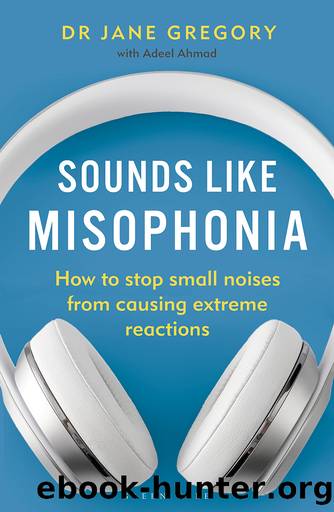Sounds Like Misophonia by Jane Gregory

Author:Jane Gregory
Language: eng
Format: epub
ISBN: 9781399404976
Publisher: Bloomsbury Publishing
Published: 2023-10-15T00:00:00+00:00
Guidelines for setting up and completing the experiments
1. Choose and prepare your sounds. Here are some different ways you could get the sounds you need to do the experiments:
â¢Audio or video recording of a generic version of the sound (from YouTube or a sound bank)
â¢Use an example of the sound from a film or TV show
â¢Ask someone you know to make an audio or video recording of the sound, or record yourself making the sound
â¢If there is one particular person whose sounds bother you most, if you have a good relationship and they are happy to help, you could ask them to record themselves doing it in their natural way
â¢Ask someone to join you on a video call and make the sounds from their end of the call
â¢Have someone in the room with you making the sounds (if they consent to being part of the experiment)
â¢Hover around in places where you are likely to hear the sound and do the experiments on the sly
2. Get a baseline rating. Listen to the sound for a few seconds before you start the experiment. Rate how strong your reaction is to the sound and mark it on the chart (see the example overleaf) under the experiment instructions. You can write down your own description or choose from one of the three options: sense of threat, violation or overwhelm. Rate the intensity out of 100 and mark it on the chart. You are welcome to rate your reaction in whatever way works for you; you donât have to use my system. Also write down what you predict will happen during the experiment.
3. Do the first trial of the experiment and decide whether to continue. Aim for around 20â30 seconds unless the instructions suggest something different. Re-rate the intensity of your reaction at the end of the first trial and mark it on your chart, if you are using one. If your reaction was worse than usual, or you had no significant reaction, you might choose not to continue with this experiment. You could check the troubleshooting options at the end of this chapter or just try a different experiment. If your reaction was similar to what it would usually be, or less intense, then continue with the experiment.
4. Repeat the experiment and decide whether to keep going. If by the end of the third trial your reaction has not decreased at all, you might choose to move on to a different experiment instead. This one might not be for you. If you are noticing your reactions are decreasing, then feel free to keep going.
5. Take a break after four or five repeats of the experiment. Take a break, switch to a different sound or try a different experiment.
6. Check whether any change occurred. After a break, listen to the sound again (without any techniques) and re-rate the intensity of your reaction to the sound. Reflect on doing the experiment and whether or not your predictions were accurate.
7. Decide whether to keep experimenting. If you
Download
This site does not store any files on its server. We only index and link to content provided by other sites. Please contact the content providers to delete copyright contents if any and email us, we'll remove relevant links or contents immediately.
Men In Love by Nancy Friday(4342)
Everything Happens for a Reason by Kate Bowler(4076)
The Immortal Life of Henrietta Lacks by Rebecca Skloot(3834)
Why We Sleep by Matthew Walker(3782)
The Sports Rules Book by Human Kinetics(3597)
Not a Diet Book by James Smith(2743)
The Emperor of All Maladies: A Biography of Cancer by Siddhartha Mukherjee(2440)
Sapiens and Homo Deus by Yuval Noah Harari(2423)
Day by Elie Wiesel(2250)
Endless Forms Most Beautiful by Sean B. Carroll(2087)
Angels in America by Tony Kushner(2054)
A Burst of Light by Audre Lorde(1984)
Hashimoto's Protocol by Izabella Wentz PharmD(1901)
Dirty Genes by Ben Lynch(1862)
Reservoir 13 by Jon McGregor(1859)
Stretching to Stay Young by Jessica Matthews(1718)
Fat for Fuel by Joseph Mercola(1700)
The Immune System Recovery Plan by Susan Blum(1698)
Boost Your Brain Power in 60 Seconds by Michelle Schoffro Cook(1680)
